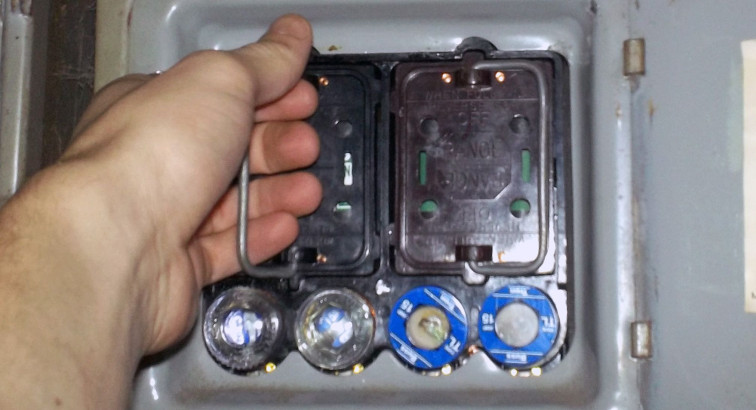Did you know that fuses in a fault or overload situation act faster than circuit breakers? Common fuses react or “blow” due to a thermal filament inside the fuse. A fault or overload causes the filament to overheat which melts it blowing the fuse. Common circuit breakers react or “trip” due to a thermal magnetic strip in the breaker. When there is a fault or overload the magnetic strip activates a tripping mechanism which puts the breaker in a “neutral-off” position. Breakers are commonly used in home wiring but when it comes to protecting equipment that could be damaged by a power surges or overloads; electrical contractors, and maintenance professionals rely on fast acting fuses to protect critical equipment.
So, if fuses act quicker why then are homes wired with circuit breaker panels rather than fuse panels? There are more than a few reasons why. Wiring homes with fuse panels began losing popularity in the late 1950's and 1960's often due to safety concerns. Now you’re saying “Wait a minute, didn’t you just say fuses act faster than breakers? Why then is a breaker considered safer than a fuse when it comes to home’s wiring?” The simple answer is because it’s harder to cheat a circuit breaker then a screw-in fuse.
There are nearly as many cheats and dangerous short cuts associated with screw-in Edison base fuses as there are fuse types. Edison base refers to the screw in base that looks like a common light bulb base. They are typically found on "T" or "TL" type fuses. (There’s also a “W” type; the predecessor to the “T” or “TL” fuses. You may still see these in old fuse boxes) Not to give anyone bad ideas, but some examples of shortcuts used in fuse panels include; putting a copper penny under a blown fuse if a replacement is unavailable, or oversizing a replacement fuse with a higher amp fuse to avoid nuisance blown fuses. Example: You’re running a blow dryer and portable heater at the same time in a bathroom and you keep blowing a 15-amp fuse. You decide to swap out the blown fuse with a 30-amp fuse; after all it fits in the fuse socket base, so it’ll work, right? Wrong decision! Now you’ve created a situation where you could overheat and damage the wiring, or the fuse may not blow at all causing the potential for a fire.
It almost seems like older homes were wired to minimum standards particularly based on the greater needs for electric devices and equipment today. Many older homes were wired with what is sometimes called a “2X4 Main and Range” fuse panel. This old panel style, as you faced it, had 2 rectangular pull out fuse blocks at the top of the box. The left side was usually the "Main" or the fuses that protected the entire electrical box with all other circuit’s downline from it. Pulling the main fuse block kills all electricity to the home except for the line side of the main. When the “Main” insert is pulled out it often reveals two larger cartridge type fuses, typically rated at 50 or 60-amps. The second pullout fuse block just to the right of the main is the "Range" fuse block. It is the only other 220-volt circuit in the fuse box intended to serve the electric range. When the “Range” insert is pulled it often reveals 2 smaller cartridge type fuses typically rated at 25-30 amps each.
Below the two rectangular pull out fuse blocks are four screw-in type Edison base fuses. Each is intended to control a single 110-volt circuit in the home. The 4 fuses usually each controlled one exterior wall and any walls extending from them whether on the first, second or any subsequent floors. For example: [fuse-1] was the east wall [fuse-2] the north [fuse-3] the west and [fuse-4] the south wall. You're probably saying "Four circuits for the entire house? That's absurd!" By today’s standards yes. By the standards of the 1940's and 50's it was thought to provide adequate wiring for an average home. Back then electricity was primarily used for lights and a few small appliances. There were also fuse panels manufactured with 6, 8, 10, 12 or 16 screw in fuses or an additional fuse pullout. But the most used in average sized homes was “2X4 Main and Range” fuse panel.
The “2X4 Main and Range” panel had no additional circuits for a 220-volt electric clothes dryer, or air conditioner and no additional 110-volt circuits for larger appliance loads or ground fault devices in kitchens, garages or on the exterior of the home. If there was a need to add a circuit for an air conditioner or dryer some panels had tap lugs at the bottom of the panel bus where an additional electrical disconnect could be tapped off the main. It was, and is still not unusual to see an older home with 2 or 3 disconnect boxes wired off an old main fuse panel.
So, are the old “Main and Range” fuse panels safe? I won’t go so far as calling them unsafe because if the branch circuit fuses are sized correctly, they still provide some protection. But many professionals consider them a safety concern or a red flag when they see them in homes for the same reasons I’ve already stated. It’s just far too easy to take safety short cuts with an old fuse panel. Plus, many of them when still in homes are just simply overloaded. It’s not unusual to see fuse terminals with more than one wire under a single screw.
It’s also not uncommon for “Main and Range” fuse boxes to have only a single point of ground. The box’s small neutral bar is typically located just below the screw in fuses. It does not allow for grounding of 3-wire electrical devices or appliances.
Installing a new electrical breaker panel requires the electrician ground the panel to the water main plus drive a ground rod at the exterior of the home. The old “Main and Range” fuse panels were not wired wrong. Over the years the codes for home electrical wiring have changed considerably. Does that mean a house with an old fuse box is not code compliant? It was wired to the codes and standards at the time it was built. Should updates or remodeling take place in the home the electrical panel and service should also have to be brought up to code? Home Inspectors often recommend that old fuse boxes get changed ASAP.
Should you change out an old fuse panel in your home? To better handle todays electrical needs, it’s not a bad idea, particularly if you have circuits protected by fuses that are oversized, or with more than one wire under a single fuse terminal, or circuits that require an actual 3-wire grounded device. It’s also far more convenient to reset a tripped circuit breaker than it is to replace a blown fuse. Murphy’s Law: Fuses never blow at convenient times and the fuse that is blown is always the size that you don’t have on hand.
When it comes selling a home, having a fuse box changed out to a breaker panel is nearly an imperative. Old fuse boxes can be a red flag for buyers and home inspectors. Having an outdated fuse box may just take your property out of the buyer’s final consideration. If your hope is getting your property sold quickly and for the most money, swapping out a fuse box for a new breaker panel may end up being one of the most important things you do when preparing your property for the market.
When considering home upgrades for safety and efficiency, replacing an old fuse panel is just one of many improvements that can make a big difference. Another often-overlooked yet crucial aspect of home maintenance is the health of your gutter system. A failing gutter system can lead to water damage, electrical hazards, and even foundation issues. Just as outdated fuse panels should be upgraded to meet modern safety standards, ensuring your gutters are clean, functional, and properly installed is essential to protecting your home. If you’re looking for expert gutter installation or maintenance, GutterGuyOmaha.com provides top-tier services to keep your home in the best shape possible.



